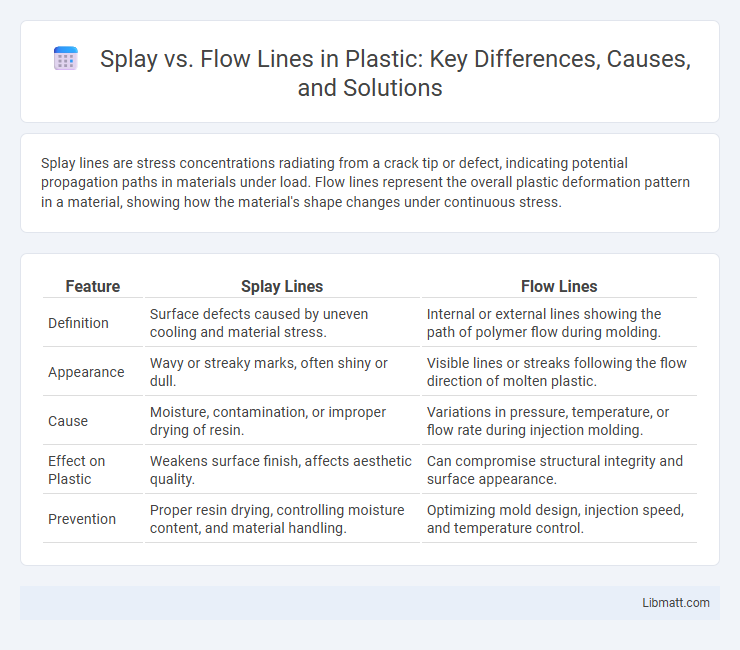Splay lines are stress concentrations radiating from a crack tip or defect, indicating potential propagation paths in materials under load. Flow lines represent the overall plastic deformation pattern in a material, showing how the material's shape changes under continuous stress.
Table of Comparison
| Feature | Splay Lines | Flow Lines |
|---|---|---|
| Definition | Surface defects caused by uneven cooling and material stress. | Internal or external lines showing the path of polymer flow during molding. |
| Appearance | Wavy or streaky marks, often shiny or dull. | Visible lines or streaks following the flow direction of molten plastic. |
| Cause | Moisture, contamination, or improper drying of resin. | Variations in pressure, temperature, or flow rate during injection molding. |
| Effect on Plastic | Weakens surface finish, affects aesthetic quality. | Can compromise structural integrity and surface appearance. |
| Prevention | Proper resin drying, controlling moisture content, and material handling. | Optimizing mold design, injection speed, and temperature control. |
Understanding Splay and Flow Lines
Splay lines represent the paths along which tectonic plates or geological features diverge from a common source, highlighting fault branching and fracture propagation patterns. Flow lines trace the movement of fluids or materials within a medium, illustrating the directional flow and velocity distribution in geological formations. Understanding splay and flow lines aids in analyzing fault mechanics, fluid migration, and subsurface stress fields in earthquake and reservoir studies.
Defining Splay Lines in Geology
Splay lines in geology are secondary fracture zones that branch off from a main fault or flow line, often indicating stress distribution and seismic activity patterns. These splay lines can influence fluid migration and mineral deposition by creating pathways that differ from the primary fault structure. Understanding your area's splay lines helps in seismic risk assessment and resource exploration by mapping subsurface deformation more accurately.
What Are Flow Lines?
Flow lines are visual representations used in manufacturing and process engineering to illustrate the movement of materials, information, and products through a production system. They help identify bottlenecks, inefficiencies, and the sequence of operations in workflows. By analyzing flow lines, organizations optimize production layouts, reduce lead times, and improve overall process efficiency.
Key Differences Between Splay and Flow Lines
Splay lines represent linear features extending from a point source, often indicating stress or displacement, while flow lines depict the continuous movement of materials or fluids across a surface or through a medium. The key difference lies in their function: splay lines highlight directional fractures or cracks, whereas flow lines map the trajectory of flow patterns in geology or engineering contexts. Understanding these distinctions helps you analyze structural behaviors and fluid dynamics more accurately.
Geological Significance of Splay Lines
Splay lines are crucial in geology as they represent secondary fault branches that distribute stress and accommodate deformation around primary fault zones. These lines influence sedimentary processes and landscape evolution by controlling fluid migration and triggering localized seismic activity. Understanding your splay lines aids in assessing earthquake hazards and predicting subsurface fluid pathways in faulted regions.
Applications of Flow Lines in Earth Sciences
Flow lines are extensively applied in Earth Sciences to model the movement of fluids such as groundwater, magma, and atmospheric currents, providing insights into hydrological cycles and volcanic activity. These lines help visualize the direction and velocity of subsurface water flow, aiding in resource management, contamination studies, and predicting the behavior of natural disasters. The analysis of flow lines also supports the interpretation of tectonic processes by illustrating mantle convection patterns and lithospheric plate movements.
Identifying Splay Lines in the Field
Splay lines are identified in the field by their distinct, radiating pattern originating from a central point, often visible as fractures or deformation features extending outward. These lines typically form due to sudden stress release or fault movement, creating zones of disrupted rock that contrast with surrounding, more coherent strata. Accurate identification involves careful mapping of fracture orientations and recognition of their relationship to fault planes and principal stress directions.
Methods for Mapping Flow Lines
Mapping flow lines involves using aerial photographs, satellite imagery, and topographic maps to trace water or airflow patterns accurately across terrain surfaces. Geographic Information Systems (GIS) enable the integration and analysis of spatial data, allowing precise delineation of flow lines based on elevation models and hydrological data. Field surveys and ground-truthing further validate mapped flow lines, ensuring accurate representation of natural drainage or airflow pathways.
Common Misconceptions About Splay vs Flow Lines
Common misconceptions about splay versus flow lines often confuse their roles in structural geology, as splay lines represent secondary faults branching off a main fault, while flow lines indicate the direction of rock movement or fluid flow during deformation. Many believe splay lines and flow lines serve the same purpose, but splay lines highlight fracture propagation, whereas flow lines trace material displacement paths. Understanding this distinction helps clarify your interpretation of fault dynamics and deformation patterns in geological studies.
Importance of Splay and Flow Lines in Sedimentology
Splay and flow lines are critical in sedimentology for interpreting sediment dispersal patterns and depositional environments. Splay lines indicate zones of sediment accumulation during flood events, revealing pathways of overbank sediment transport, while flow lines trace the directional movement of sediment-laden currents within channels. Understanding these features aids in reconstructing paleo-flow dynamics and sedimentary processes that control reservoir quality in hydrocarbon exploration.
Splay vs flow lines Infographic

 libmatt.com
libmatt.com